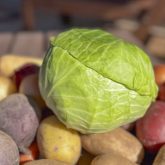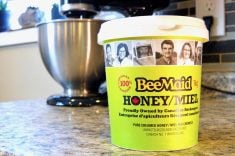Inside the barn, it’s always a hot summer night. It’s 34 C, and a million crickets sing a soft but steady chorus.
Outside the barn, it’s a textbook, idyllic early-harvest day on a Manitoba farm. A handful of cattle chew their cuds in a nearby pasture. The wheat across the drive is in the late stages of ripening.
Read Also

Mandatory holiday joy a valid struggle
Christmas may not be that jolly for everyone. Farm family coach Kalynn Spain suggests those struggling with over-the-top joy during the holidays instead aim for “fulfilled” or “content.”
This is Lesley and Ryan Steppler’s past, present and future in microcosm. The two grew up on beef cattle and grain farms and say they’re proud of that heritage.
Their south-central Manitoba farm is surrounded by family farms – parents, uncles and aunts, siblings and cousins – affectionately called ‘Stepplerville.’
Today they farm grain and an ever-growing ‘herd’ of crickets.
Crickets in the vents
Though both were farm kids, Ryan and Lesley met while working well away from the land. He’s a former teacher. She’s a former social worker. Ryan returned to grain farming at age 29, which he did while teaching full-time.

Crickets weren’t part of that plan, but an off-hand conversation with his dad, who’d recently learned about cricket farming, piqued Ryan’s curiosity. He got on Google.
The result: a hydroponics tent in their basement holding 200 crickets.
This was Ryan’s hobby. When the tent was zipped, Lesley could ignore the fact that there were 200 crickets in her house.
Except for the escapees.
“They would get into our vents, and it would be two in the morning and [Lesley] would be like, ‘there’s a cricket in the vent,’” Ryan said.
“Go get this cricket. I can’t sleep!” Lesley added.
At first, Ryan used a community commercial kitchen to boil, dehydrate and grind the bugs into protein powder for a waiting list of family and friends.
His cricket ‘mill’ was a push-button coffee grinder, which had to be shaken vigorously. It was an excruciatingly slow process, but food processors, blenders and other mills would gum up with cricket fat.
Ryan could process just over two bags of protein powder per session, which was not enough to supply stores. Yet early on, he knew he was onto something.
When the basement cricket herd couldn’t keep up, they moved into a room in his dad’s shop, built a new cricket ‘barn’ and added a commercial kitchen of their own.
Today, their powder and roasted crickets are sold in grocery stores all over Manitoba. The business is growing every month.
What’s in a cricket?
People have been eating insects for millennia. In the Bible, for instance, John the Baptist is said to have eaten locusts and honey while he preached in the first-century Israeli wilderness.

In Thailand, insects make a nice, light snack; so much so that Hotels.com made a guide for tourists about eating them. It includes deep-fried grasshoppers (“you’ll find them surprisingly moreish,” the article says); red ants fried in soy sauce and oil; silkworms fried with citrusy kaffir leaves; and, of course, crickets.
For Lesley, and many other Canadians, eating them wasn’t appealing at first. But powdered crickets blended seamlessly into smoothies, so she adopted that quickly.
Whole roasted crickets? “That was probably years later,” she said. Once she tried them, her reaction was about the same as anyone else’s, Lesley said.
“Oh, that wasn’t bad at all. That was good.”
What appealed to Lesley, a trained nutritionist, was all the good stuff crickets provided. A 75-gram packet of their chocolate-covered crickets, for instance, has 22 grams of protein, six grams of fibre, 500 mg of potassium, 50 mg of calcium, 8.5 mg of iron (nearly half of an average person’s daily requirement), and 88 per cent of person’s daily vitamin B12 requirement.
What do they taste like?
Something between a nut and a legume, a Co-operator reporter decided after tasting them. A bin of roasted crickets smells a little like chocolate or roasted chicory. Lesley and Ryan add flavours like chocolate or barbecue seasoning to the roasted crickets.
It’s rewarding to produce a nutritious product for people, Ryan and Lesley said. Few things feel better than a text from a customer who introduced cricket powder to a friend, who enjoys it in protein shakes and sees good results.

There are other rewards too.
Lesley and Ryan’s young children have watched them build a business from scratch, and now get to farm alongside them. After all, they won’t get trampled by a herd of stampeding crickets, though the barn gets too hot sometimes.
Dealing with hate
Recently, however, the Steppler family encountered a new challenge: online hate.
A far-right site blasted them after their products were handed out as prizes in a school classroom. The site claimed kids were being “brainwashed to eat bugs by the relentless efforts of globalists, left-wing media, and some educators.”
The Stepplers have received threatening voicemails and emails and have been told they’re a disgrace and enemy of farmers.
It’s bewildering and discouraging, the Stepplers said, especially when their farming heritage is so important to them.
“We have a freezer full of beef!” Lesley said. “We don’t want it to be an us versus them thing.”
From the get-go, they understood that people might give them funny looks and balk at eating crickets, said Ryan, but hate email was unexpected.
Variety is good for people’s health, Lesley said. Many people don’t get enough protein, which can cause a variety of health problems. In her nutrition counselling business, she encourages people to get protein from multiple sources, including meat, but some people don’t want to eat meat, or can’t.
“We want people to have the nutrition that they need,” she said.
















